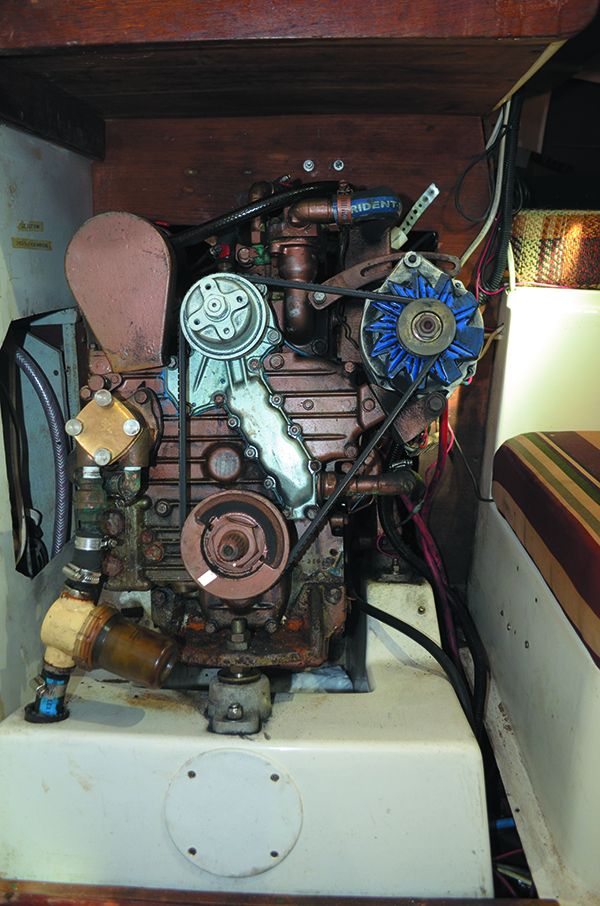
My 1980 Tartan 33 Cynosure still turns heads. But like any piece of machinery, the Tartan 33 needs to be maintained. For someone looking at a used Tartan 33, or other Tartan from that era, here are some areas of concern.
- Chain plate area – Tartan chain plates are a flat slab of stainless steel that passes through the deck and mounts to the mid-ship bulkhead. The through-deck area includes an escutcheon plate. Part of normal maintenance is renewing the chalking/waterproofing in this area. Throughdeck leaks usually first show as discoloration on the chain plate. Leaks can lead to bulkhead damages as well.
- Genoa tracks – As these boats age, the waterproofing on the Genoa tracks needs renewing. The good news is that the port side is super easy. Remove a piece of molding over the pilot berth, and with some help from someone topside you can loosen the fasteners. The starboard side is not so easy. To access the nuts under the Genoa track requires removing the top of the cabinets and one of the partitions.
- Portlights – At this point in their life cycle the Beckson ports are likely to leak, which stains or harms the interior teak. It is possible to replace the lenses and renew (clean) the rubber gaskets, but purchasing new Beckson ports is often the best option.
- Engine – The Universal 5424 /Kubota engine is a classic old-school diesel. Be sure to show the engine you care- change the oil, give her clean fuel and keep her cool, and she will run fine. At this point in the engine’s life consider replacing the glow plugs and replacing or rebuilding the injectors.
- Starboard drinking water tank- These tanks are famous for leaking. I finally decided to place a collapsible tank inside my existing tank.
Room for improvement
- Sails – The best way to both enhance your ride and be the envy of sailors with newer production boats is to put a good set of sails on her.
- Jib shaping – the T-33 is a roller furling fractional rig with the ability to point fairly well. The compromise to this design is that keeping the correct jib sheet angle (vertical and inboard/outboard) is a challenge. The reward for good sail quality and good sheet angle is a peppy old boat (think 60% TWS). So how do you get your jib angle right?
1) Purchase Garhauer adjustable cars. This relatively inexpensive upgrade allows you to easily open and close the leech regardless of reef.
2) Purchase 2-3 snatch blocks. When the AWA is 80 degrees or higher, the jib develops a hook. This is where the slotted toe rail comes in handy (aside from not needing varnish). Take the jib sheet through a snatch block mounted at the boarding gate and then through the genoa car (pulled fully aft), which creates an effective jib shape.
- Jib size – When I purchased my boat she had a 135 and a 150 that was a thin light-air sail. I found the 150 to be simply too much sail in winds above 10 knots. When it came time to replace my jib, I purchased a 135%, 8.1-oz., tri-radial jib. Soon after, she had a matching 8.1-oz. tri-radial main (see cover photo).
- Main sail trim – The relatively large main sail requires attention. The T-33 likes to sail more upright so be ready to ease the main (under-trim) in the gusts.
- Ice box – Most of these boats have been retrofitted with refrigeration. Consider adding 1” of pink foam to make the ice box more efficient.
- Cabin overhead – when replacing the wood and fabric in my overhead I placed ½-inch insulation and added recessed lighting. Replacing the wood and fabric eliminated the old-boat-smell. Adding recessed lighting with switches by the companionway made the cabin much brighter.
- Countertops – The paucity of veneer, means dings to the wood can be oiled to darken, which then become part of the boat’s patina. The exception is its Formica countertops, which will yellow with age. With some basic wood working skills, the Formica can be easily replaced.
Practical Sailor boat reviewer and products and electronics tester Capt. William Herrmann is a delivery skipper based in St. Petersburg, Florida. His website is www.uscgcaptain.com.





































